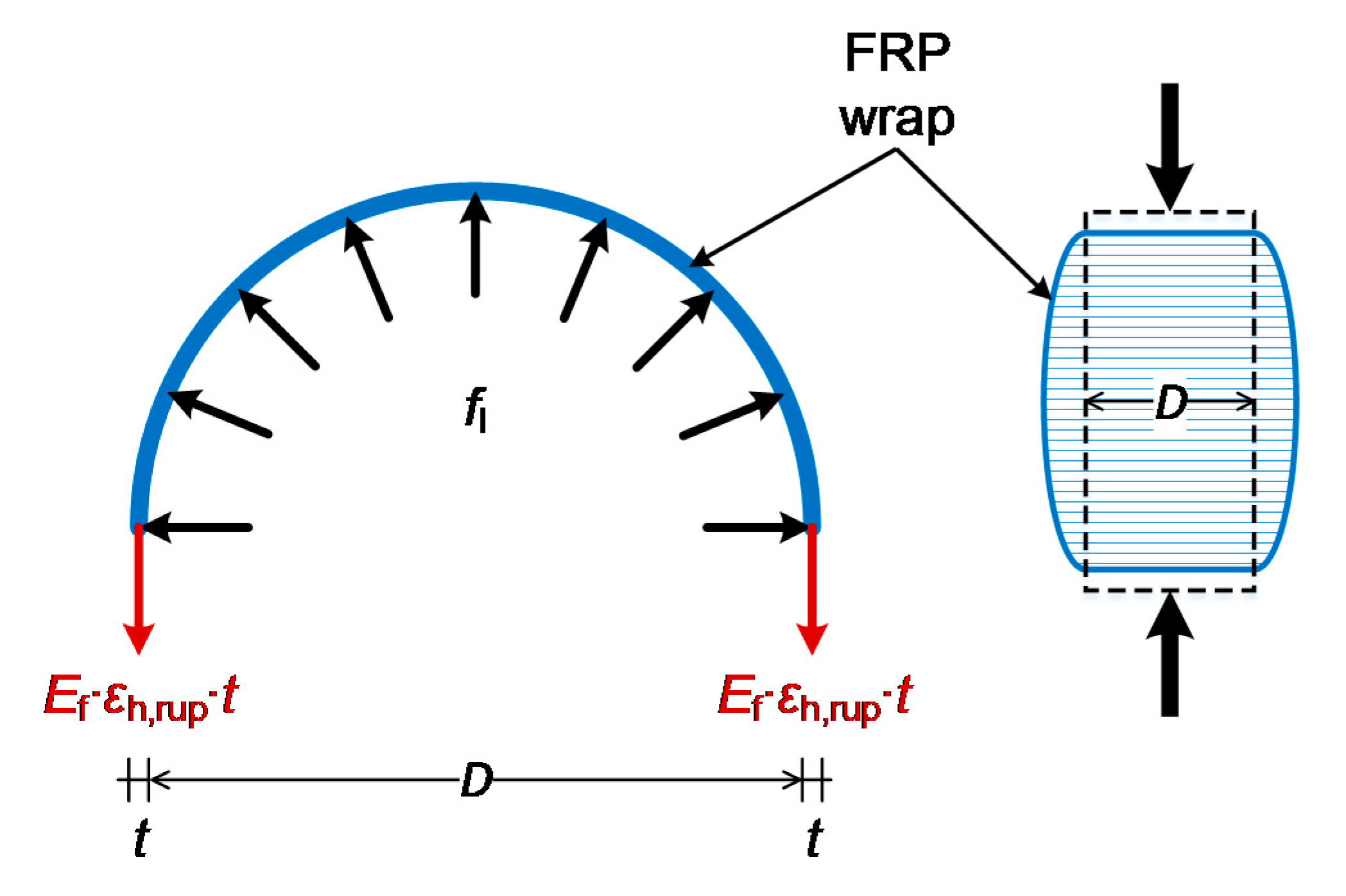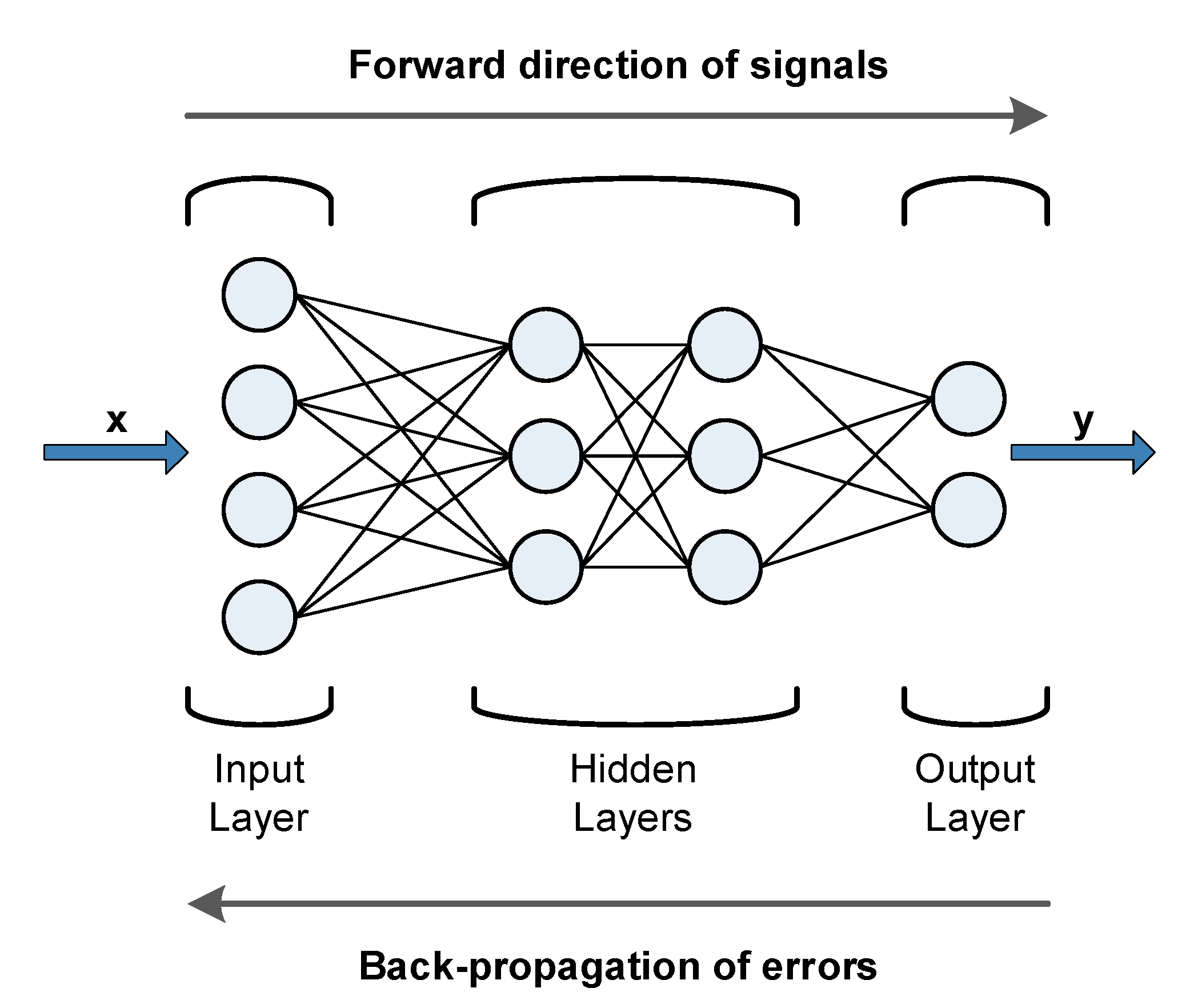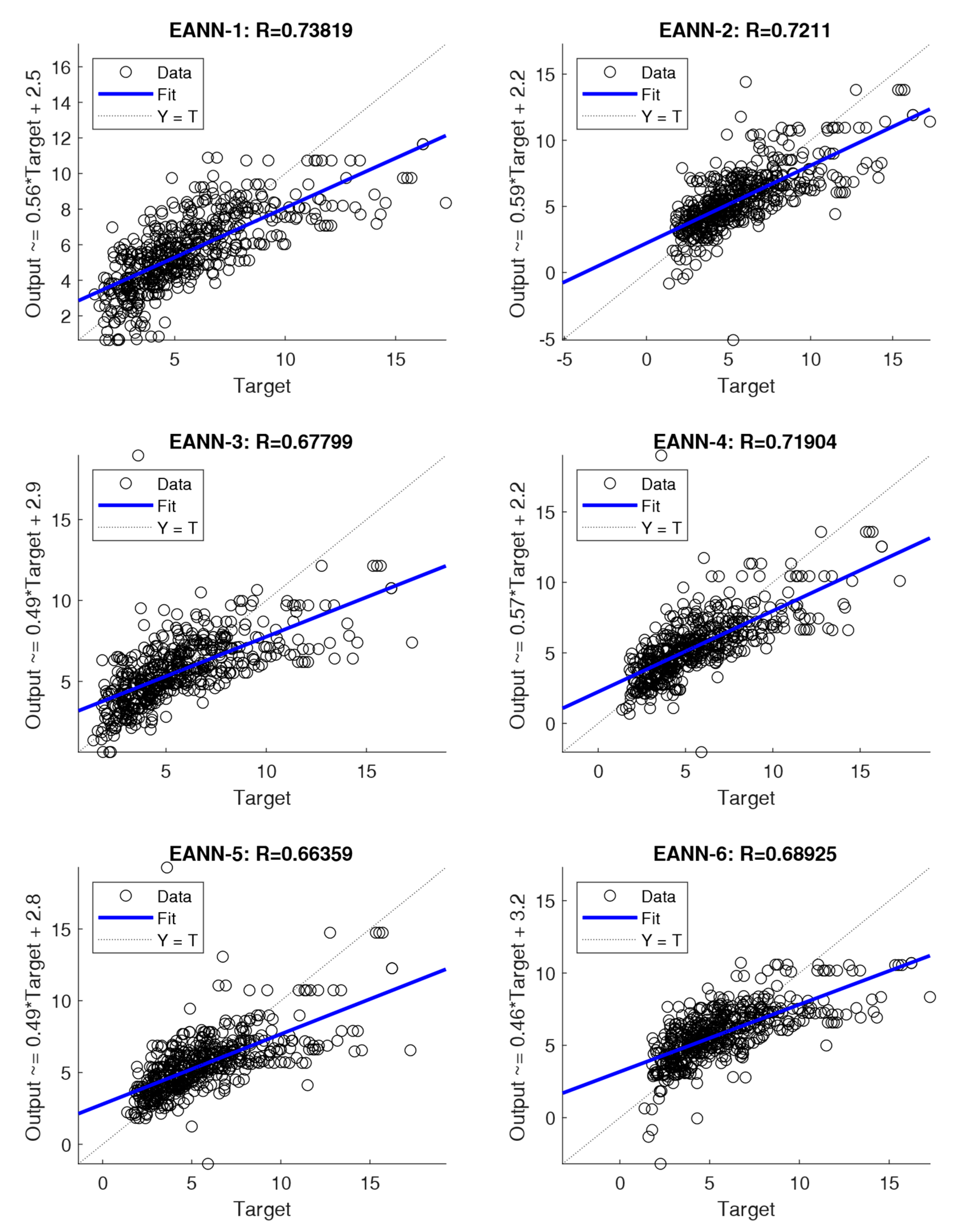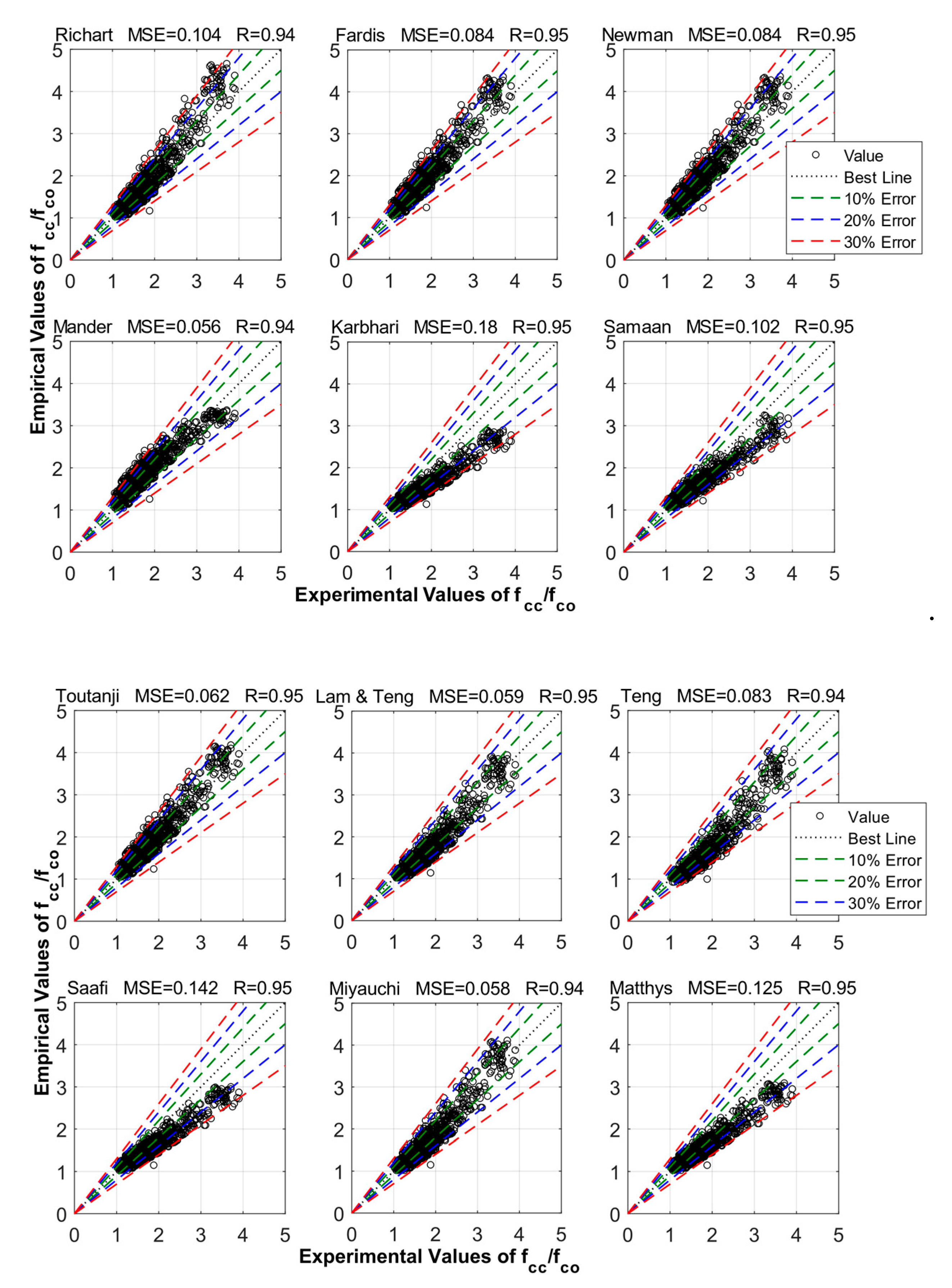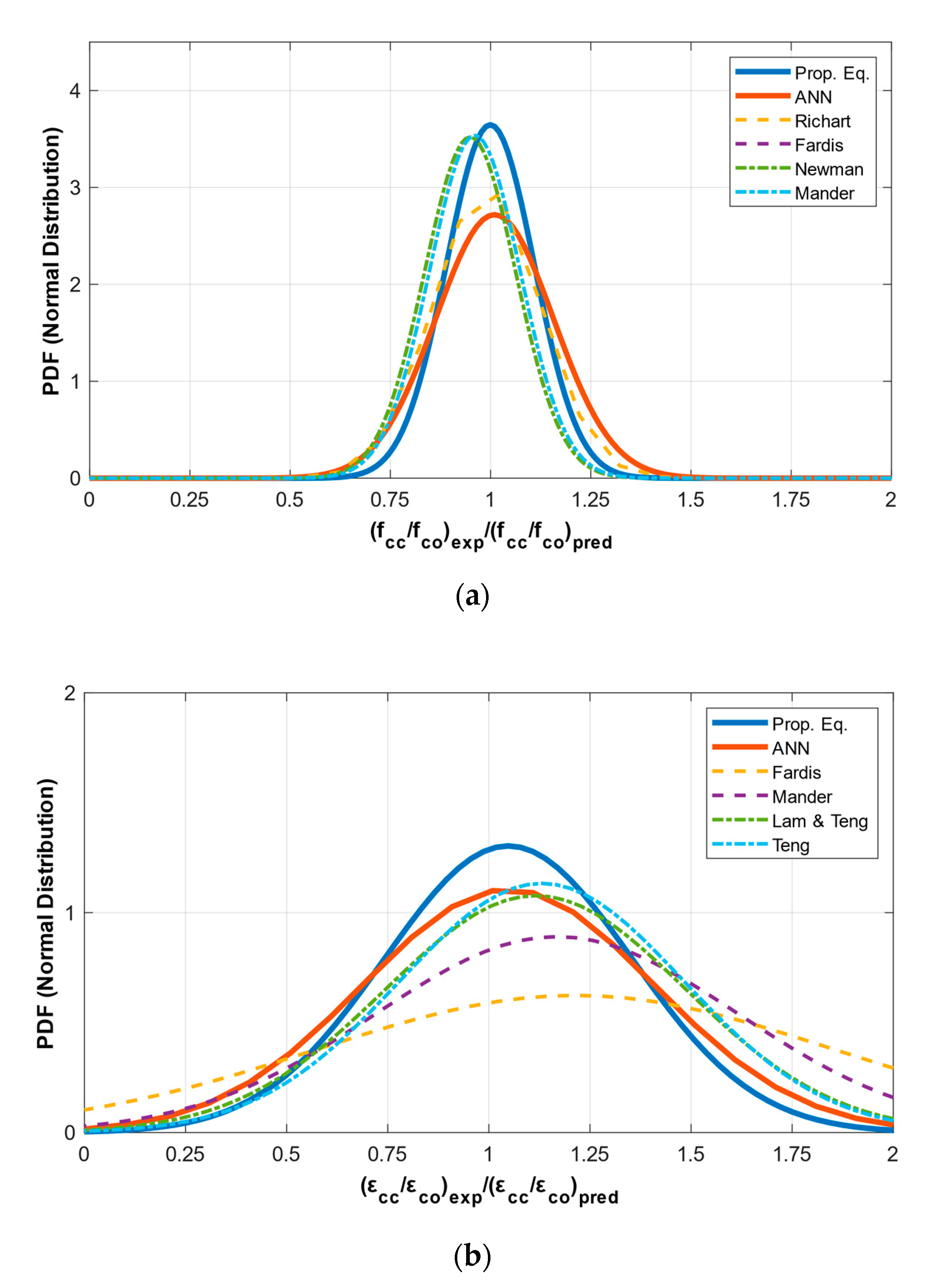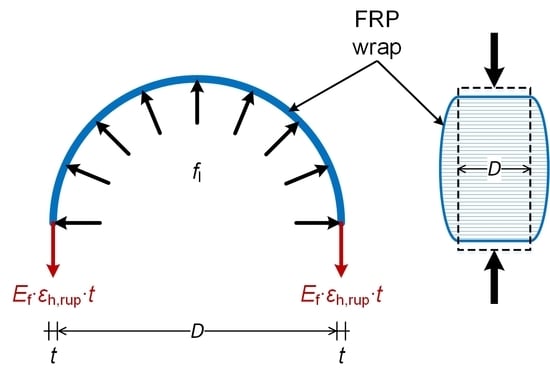1. Introduction
The lateral confinement due to fiber-reinforced polymers (FRPs) increases the efficiency of concrete compression members by enhancing their axial load carrying capacity and ductility. The increase in axial strength and strain of reinforced concrete (RC) columns is the main reason for using FRP confinement techniques. Over the last decade, the use of FRP composites for the rehabilitation, retrofitting, strengthening, and ductility enhancement of RC compression members has been one of the most popular techniques due to its advantages [
1]. The advantages of the FRP composites include not only the corrosion resistance and low weight, but also provide a high strength to weight ratio. The critical parameters affecting FRP are the thickness of FRP (
nt), angle of orientation of FRP wraps, the elastic modulus of FRP (
Ef), total number of FRP sheets, and the unconfined strength of concrete material (
f′
co) [
2]. FRPs offer many advantages, such as easy handling, low disturbance of concrete members, easy installation, and little time for application [
3]. Due to these advantages, FRPs are preferred over the use of conventional steel jacketing techniques [
4].
The technique of strengthening RC structures using FRPs is very vital for increasing the capacity of RC structural members at the ultimate limit state (ULS) [
5,
6]. Poor and low strength concrete or concrete structures damaged due to lateral seismic loading usually lose strength, and they need retrofitting and rehabilitation to regain their strength at ULS [
7]. The use of fiber and plastic makes the FRP high corrosion resistance and suitable for use in undersea structures [
8]. The applications of FPRs are not limited to RC building members but are also extended to RC bridge piers, girders, and slabs to enhance their strength at ULS [
9,
10,
11,
12,
13,
14,
15,
16].
Many researchers have done work for estimating the axial strength and strain of externally confined concrete members [
17,
18,
19,
20,
21,
22,
23,
24] based on empirical techniques [
25,
26,
27,
28,
29,
30,
31,
32,
33,
34,
35,
36,
37,
38,
39,
40,
41], i.e., Karbhari et al., Miyauchi et al. [
42,
43], Lam and Teng [
44], and Mander et al. [
45], as described in
Table 1. These proposed empirical equations predict the strength and strain capacity of confined concrete members with low accuracy [
46]. The use of artificial neural networks (ANNs) for modeling various complex problems in structural engineering is increasing [
47,
48,
49,
50,
51,
52]. One can determine and capture the interactions between various variables of a complex system by using ANNs, despite the unknown and usually unpredictable nature of these interactions. ANN models can predict the compressive strength of confined plastic concrete accurately [
53,
54,
55,
56]. Khademi et al. [
57] and Reddy [
58] used ANN techniques for the prediction of the axial strength of confined concrete. Moreover, various researchers proposed analytical models for the prediction of the ultimate conditions of confined concrete members using different techniques such as ANN, regression analysis, soft computing, and genetic programming [
25,
26,
27,
28,
29,
30,
31,
32,
33,
34,
35]. An attempt has been made [
59,
60] to determine the confinement effects of the FRP on RC members at the ULS.
The present work aims to propose a prediction model for the axial strength and axial strain models for FRP-confined concrete cylinders. Similar approaches have already been proposed in the past, mainly for strength models [
18], using only a limited database. In the present work, previous experimental results of concrete cylinders externally confined with FRPs, in particular 708 specimens for strength and 512 for strain, were collected and evaluated based on some statistical indices, such as the correlation coefficient (R) and mean square error (MSE). This was done using the previously proposed models for the ultimate conditions of FRP-confined concrete members. In addition, ANN and empirical models are proposed for the prediction of strength and strain of concrete members with FRPs. The evaluation of previous and currently proposed models for the ultimate conditions of FRP-confined concrete members show that the proposed models provide superior performance. The significance of the present study is that the proposed models can also accurately capture the axial strain behavior of confined concrete, which is useful for the analysis and design of confined concrete members.
2. Mechanics of FRP Confinement
It was observed that the models for the ultimate conditions of FRP-confinement contain some common variables, such as confinement stiffness ratio (
ρk), strain ratio (
ρε), hoop rupture strain of fibers (
εh,rup), and maximum confinement stress (
fl). The relations for
ρk and
ρε have been presented by Teng et al. [
61], as described in Equation (1) and Equation (2).
where
εco is the axial strain of unconfined concrete,
t is the thickness of FRP wraps,
f′
co is the unconfined strength of concrete, and
Ef is the tensile modulus of confinement sheets in the transverse direction of the specimen.
Figure 1 represents the confinement stresses due to FRP-wraps with a hoop diameter
D.
The relationship between confinement stress and some critical variables is illustrated in
Figure 1 and Equation (3). The hoop rupture strain can be represented by Equation (4) [
62].
where
εf is the maximum tensile strain of fibers, and
f′
co is expressed as in MPa units. The initial strength and strain model for the FRP confinement was given by Fardis and Khalili [
63] based on the concept that the maximum strain of FRP confined concrete is increased with the enhancement of the circumferential stiffness. Mander et al. [
45] proposed a model for the predictions of the axial compressive strain of FRP that was initially implemented by ACI 440-2R-02 [
64]. Samaan et al. [
59] proved this concept to be wrong by developing a strain model with the concept that the actual hoop rupture strain is less than the maximum tensile strength of FRPs at the failure stage. Karbhari and Gao [
42] proposed a model for strain by assuming that the FRP wraps reach their ultimate tensile strength during the application of load, which is not possible for the actual conditions. By considering the concept of the actual rupture strain of FRPs, Toutanji [
65] suggested a new strain model. Lam and Teng [
44] proposed a new strain model by considering the actual failure strain of FRPs. Later on, Teng et al. [
66] refined this model by performing tests on 18 FRP confined concrete members.
Table 1.
Previously proposed strength and strain models of fiber-reinforced polymers (FRP) confined concrete specimens.
Table 1.
Previously proposed strength and strain models of fiber-reinforced polymers (FRP) confined concrete specimens.
| Model | Relationship for Strength | Relationship for Strain |
|---|
| Karbhari and Gao [42] | | |
| Saafi et al. [67] | | - |
| Matthys et al. [60] | | - |
| Fardis and Khalili [63] | | |
| Richart et al. [68] | | - |
| Newman and Newman [69] | | - |
| Mander et al. [45] | | |
| Lam and Teng [44] | | |
| Toutanji [65] | | |
| Samaan et al. [59] | |
|
| Teng et al. [61] | | |
| Miyauchi et al. [70] | | - |
3. Artificial Neural Networks (ANN)
In neuroscience, a (biological) neural network describes a population of physically interconnected neurons or a group of disparate neurons whose inputs or signaling targets define a circuit. It was found that mammalian brains learn as connections between neurons are strengthened. ANNs mimic the biological neural networks and, like human beings, learn by example. ANNs can evaluate the complex functions of numerous variables whose interrelationships are not clear. Learning, categorization, and generalization are processes that are adopted by the ANNs to predict the outputs. The ANNs perform these tasks because of their ability to save the calculation data in memory during the training process. They contain a number of hidden layers consisting of a complex interrelationship of hidden “neurons”. There is a link between every two neurons of consecutive layers, having a specific weight. The predictions of neurons are then multiplied with these weights. During the latter process, the predictions of neurons are transferred through the links and added to the bias, as presented in
Figure 2 [
71].
Based on experience [
72,
73], it is considered that the multilayer feed-forward ANNs (MLFNNs) are the most suitable for this type of problem. In MLFNNs, there is an input layer, an output layer, and one or several hidden layers. In this study, we particularly use back-propagation neural networks (BPNNs). A back-propagation neural network is a feed-forward, multilayer network of standard structure, i.e., neurons are not interconnected within a layer, but they are connected with all the neurons of the previous layer and the subsequent layer. In this type of ANN, the output values are cross-checked with the target answer to get the error value. To reduce the error value, different techniques are used [
72,
73] by changing the weights of each connection during a large number of training cycles. In this case, one would say that the network has learned a certain target function. As the algorithm’s name implies, the errors propagate backwards from the output nodes to the input nodes. The selected architecture of the NN defines the number of hidden layers and the number of neurons in each layer.
Figure 2 depicts an example of a BPNN composed of one input layer with four neurons, two hidden layers with three neurons each, and an output layer with two neurons, i.e., a 4-3-3-2 BPNN with two hidden layers.
As shown in
Figure 2, a BPNN consists of several layers, and each layer contains a complex system of interconnected “neurons”. There is a link between neurons of subsequent layers, having a specific weight. The values generated by the neurons are then multiplied with these weights. During the latter process, the values generated by the neurons are shifted via links and then summed with bias, as shown in
Figure 3, which depicts a single node (neuron) of a hidden layer, with a single R-element input vector.
This summation is then presented into a predefined activation function, as shown in Equation (5).
where
a is the output of the neuron,
wi is the weight coefficients,
pi the input values, and
b is the bias value. In matrix form, the above equation can be written as Equation (6),
where the sum
wp, is the dot product of the (single row) matrix
w = {
w1, …,
wR} and the vector
p = [
p1, …,
pR]
T.
The outputs of the activation function generate the values for the input process of neurons of the next layer. The final values of the weights are obtained from the learning process based on available data after assigning random initial weights in the beginning. In the present study, ANNs are utilized to predict the axial compressive strength and the axial compressive strain of confined concrete cylindrical elements. The error resulting from this process can be calculated by Equation (7),
where
T is the target defined in the database, and
O is the output value predicted by the ANN. For the strength model, we use a BPNN model, where the five input parameters are the diameter of the cylinder
D, the height of the cylinder
H, the total thickness
nt, the elastic modulus of FRP
Ef, and the compressive strength of unconfined concrete
f′
co. The single output parameter is the compressive strength of confined concrete
fcc. For the strain model, we similarly used a BPNN model, where the five input parameters are
D,
H,
nt,
Ef, and the compressive strain
εco. In this model, the single output parameter is the compressive strain
εcc corresponding to the compressive strength of confined concrete
fcc. The parameters for both NN models are shown in
Table 4.
The back-propagation technique or Delta rule [
74] was used to minimize the error of Equation (7). This iterated search process was carried out in the opposite direction, i.e., from right to left of the NN, as shown in
Figure 2. This process aimed to adjust the values of the various weights, which were randomly selected in the beginning so that the output values realistically agreed with the required target values of the database. This process was repeated until there was no further improvement in the mean square error value, and the errors became acceptable. In the end, the trained ANN can be used to predict results even for data that have not been presented to it before, with small error.
3.1. ANN Architecture
A number of parameters need to be set up for the ANN, for example, the activation functions between consequent layers, the total number of neurons in each layer, the activation functions between the hidden layers and the output layer, and others. The choice of these parameters depends on the given problem and can be determined by a trial and error process. For this investigation, we took six ANN architectures into account, as shown in
Table 5. The 6 + 6 Models (6 for strength and 6 for strain) had different numbers of hidden layers and nodes in every hidden layer. The logistic and hyperbolic activation functions were utilized between the input and the middle layer, based on the authors’ experience [
71], while the hyperbolic activation function was utilized between the output layer and its previous layer.
3.2. Normalization of the Databases
The ANNs work best with normalized data for inputs and outputs. This process helps avoid low learning rate issues [
48]. In the present study, all the parameters associated with confined concrete cylinders were normalized using Equation (8). This process made all the parameters unitless despite the different units that were used to describe the various inputs or outputs.
In Equation (8), x is the actual value, X is the new normalized value, Δx is the difference between the maximum and minimum x value, xmax is the maximum x value, and Xmax and ΔX are the new desired maximum value of X and the new desired difference between the maximum and minimum X value, respectively. In our case, we used the parameters Xmax = 0.9 and ΔX = 0.8 to end up with normalized values that were in the range [0.1, 0.9]. The same equation, Equation (8), in a rearranged form, was used for the denormalization of the strength and strain values, i.e., to end up to the real values of strength and strain from the normalized ones provided by the NN.
3.3. Performance of the Various ANN Models
It is very important to calibrate the proposed ANN models based on the experimental results to investigate the accuracy of the generated model. The multilayer free forward back-propagation (MLFFBP) process [
48] and the testing results were used for the calibration of the current ANN model. The training process of ANN was adopted as described in the authors’ work [
75].
Overtraining (or over-fitting) can be a problem as it causes the ANN to lose its generalization capability. To avoid overtraining, the size of the network and the number of training epochs should be in correspondence with the complexity of the problem, especially if the training data contains a significant amount of noise. An excessive number of training epochs, or an excessive size of the neural network, can cause network overtraining. In our case, to enhance the performance of ANN and to avoid overtraining, the data were divided into three sets: one for training, one for validation, and one for testing purposes. Sixty percent of sample points were used for training, 20% were used validation, and 20% were used for testing purposes. The ANN models were developed using MATLAB [
49].
There were 100 epochs for the training of each ANN model that included the MLFFBP process. The MLFFBP process continued until any of the following conditions was completed: (i) 20 failures occurred in the validation process during the iteration, to avoid overtraining, (ii) the performance goal (the difference between the target and the output values) became equal to a preset value of 0.0001, (iii) the minimum performance gradient became equal to 10
−10. The rate at which the MLFFBP process adjusts the weights of the sample points is known as the minimum performance gradient. These conditions were used, as suggested by the Levenberg–Marquardt back-propagation technique [
49]. This technique is a second-order algorithm that works with second derivatives.
Table 6 and
Table 7 present some statistical information about the ANN model predictions (target values) for the strength and the strain models, respectively. The tables contain the minimum values (
min), the maximum values (
max), the difference between the two (
Range =
Max–
Min), the average values (
Mean), the median values (
Median), the standard deviation (
StDev) and the coefficient of variation (
CV =
StDev/
Mean). Some negative values can be found for the
Min values of
fcc/
f′
co and
εcc/
εco in the table, which make no sense and are only artifacts of the method that do not affect the overall results.
Equations (9)–(11) show the formulas used for the calculation of the correlation factor R, the mean squared error (MSE), and the mean absolute error (MAE), respectively. These three metrics were used to evaluate the different models. When the ANN outputs
O match the targets
T perfectly, then R→1, MSE→0, MAE→0 [
76,
77,
78].
In the above formulas, Ti and Oi are the values established experimentally (target values) and with the use of the ANN, respectively. The number of data points is denoted by n, while and are the average values of the experimental and the predicted values, respectively.
Table 8 shows the prediction performance of the six NN models for strength and strain. It has to be noted that these values correspond to the normalized values of
fcc/
f′
co and
εcc/εco, for the strength and strain models, respectively.
Figure 4 shows the values of MSE, MAE, and R for the six different NN models for strength and strain. The models corresponding to the least values of MAE and MSE and the highest value of R can be considered as the best models which can accurately predict the axial strength or strain of confined concrete. It can be concluded that the ANN strength model with the highest value of R (91.2%), together with the lowest values of MSE (5.68%) and MAE (5.45%), was the third model, i.e., FANN-3.
Similarly, the ANN strain model with the highest value of R (71.9%) along with the lowest values of MSE (9.29‰) MAE (6.80%) was the fourth model, i.e., EANN-4. Thus, FANN-3 (5-5-5-1 architecture) and EANN-4 (5-10-10-1 architecture) were selected as the final models for the prediction of the axial strength and axial strain of cylinders.
Figure 5 and
Figure 6 depict the output values of the different NN models vs. the target values for strength and strain graphically, respectively.
5. Comparative Study
For a comparative study of the proposed ANN model, the proposed analytical model, and other models from the literature, we drew the probability density functions (PDFs) of the results of the various methods as normal distributions based on the mean value and the standard deviation of the experimental ratio (fcc/f′co and εcc/εco) divided by the corresponding predicted ratio for each method. A good prediction would mean an average value close to 1 and the PDF curve being tall and as narrow as possible (standard deviation as low as possible). Wider curves denote a higher standard deviation from the mean value.
Figure 11 shows the results for the strength (a) and the strain (b) models. For illustration purposes, for the strength model, the comparison was made with the results from Richart [
68], Fardis [
63], Newman [
69], and Mander [
45], while for the strain model, the results were compared with the ones from Fardis [
63], Mander [
45], Lam and Teng [
44], and Teng [
61].
For the strength model, the proposed analytical model and the proposed ANN model showed the best results with mean values close to 1 (1.00 and 1.01, respectively), while from the other models, the one of Richart had the best mean value (0.99) with a standard deviation of 0.132. The standard deviation of the proposed analytical model and the proposed ANN model were 0.109 and 0.146, respectively.
For the strain model, again, the two proposed models showed very good results with a mean value of 1.05 (for both) and standard deviations 0.306 for the proposed equation and 0.360 for the proposed ANN. For comparison, the Teng and the Lam and Teng models had mean values of 1.13 and 1.12, respectively, with standard deviations 0.352 and 0.370.
It should be noted that the results were better for the strength models in general (better mean values and smaller deviation), compared to the strain model. The proposed models for confined concrete are capable of providing accurate results for confined concrete strength and strain, in comparison to other models in the literature.
Figure 12 shows the distributions of the ratios
fcc/
f′
co and
εcc/
εco provided by each method. The black bar denotes the experimental (target) values. Again, the proposed equation and the proposed ANN model gave the best results with distributions that were closer to the targets.
